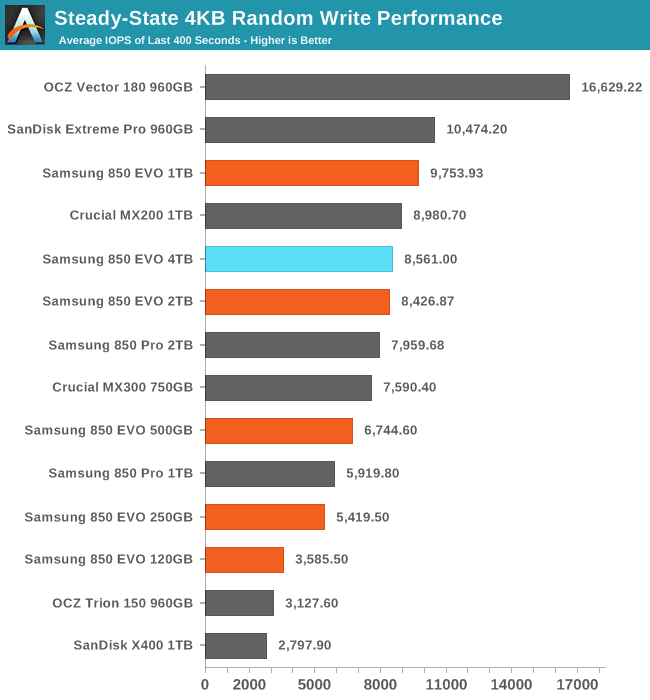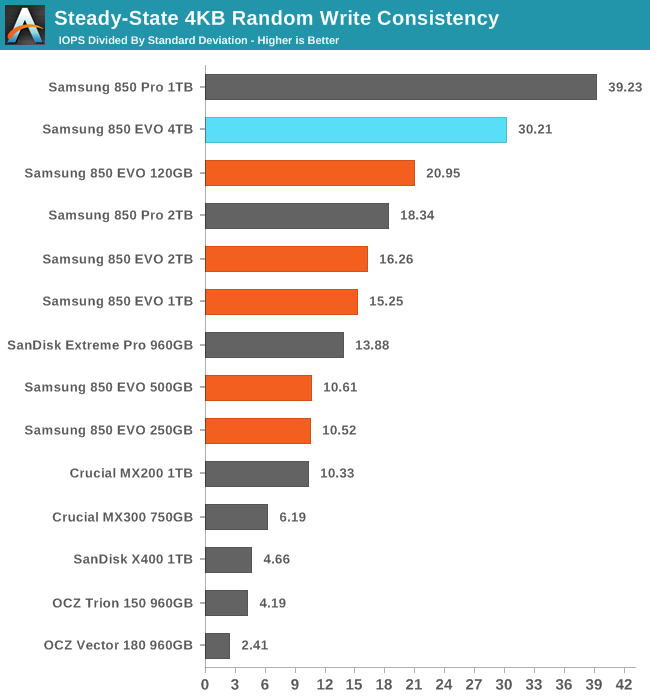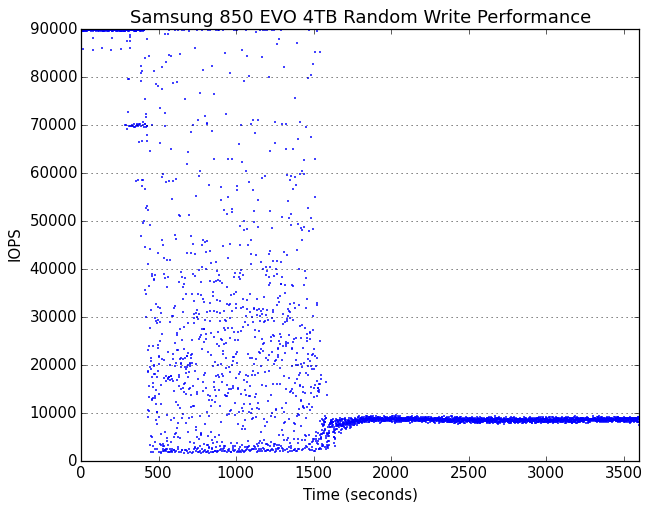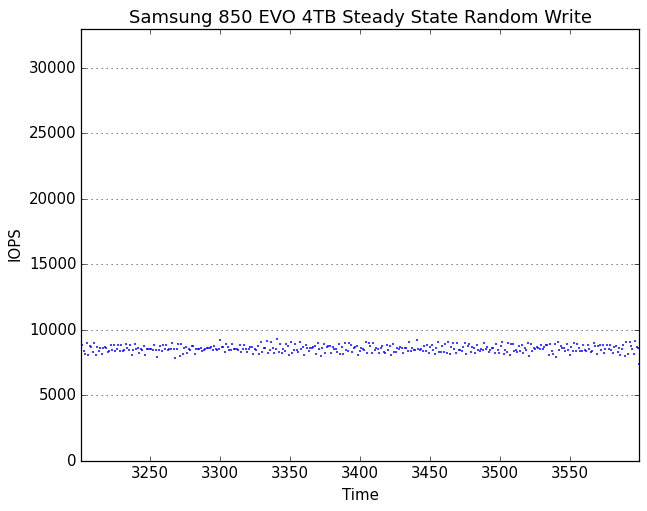The Samsung 850 EVO 4TB SSD Review
by Billy Tallis on July 11, 2016 10:00 AM ESTPerformance Consistency
Our performance consistency test explores the extent to which a drive can reliably sustain performance during a long-duration random write test. Specifications for consumer drives typically list peak performance numbers only attainable in ideal conditions. The performance in a worst-case scenario can be drastically different as over the course of a long test drives can run out of spare area, have to start performing garbage collection, and sometimes even reach power or thermal limits.
In addition to an overall decline in performance, a long test can show patterns in how performance varies on shorter timescales. Some drives will exhibit very little variance in performance from second to second, while others will show massive drops in performance during each garbage collection cycle but otherwise maintain good performance, and others show constantly wide variance. If a drive periodically slows to hard drive levels of performance, it may feel slow to use even if its overall average performance is very high.
To maximally stress the drive's controller and force it to perform garbage collection and wear leveling, this test conducts 4kB random writes with a queue depth of 32. The drive is filled before the start of the test, and the test duration is one hour. Any spare area will be exhausted early in the test and by the end of the hour even the largest drives with the most overprovisioning will have reached a steady state. We use the last 400 seconds of the test to score the drive both on steady-state average writes per second and on its performance divided by the standard deviation.

The 4TB 850 EVO restores a little bit of the performance that the 2TB lost relative to the 1TB, but Samsung's controller architecture is still clearly most comfortable at 1TB.

The consistency of the 2TB 850 EVO was only slightly better than the 1TB EVO, so it's surprising to see the 4TB model make such a large jump and come so close to the 1TB 850 Pro.
 |
|||||||||
| Default | |||||||||
| 25% Over-Provisioning | |||||||||
It is no surprise that a 4TB drive lasts so long before dropping out of peak performance: it has far more spare area to burn through than any ordinary consumer SATA SSD. The transition to steady state is uncharacteristically long and messy for a Samsung drive, and the performance lows during this period are disappointing. Once the drive has reached steady state, there's nothing to complain about.
 |
|||||||||
| Default | |||||||||
| 25% Over-Provisioning | |||||||||
There are no wild outliers from the 4TB 850 EVO's steady-state, and none of the longer-term drift in performance shown by the 1TB and 2TB 850 EVO and Pro models. With extra overprovisioning, the 4TB EVO carries on indefinitely with high and extremely steady performance.










145 Comments
View All Comments
JellyRoll - Monday, July 11, 2016 - link
It is relative. 75 total drive writes of 4TB are huge.Daniel Egger - Monday, July 11, 2016 - link
Not at all. There're many scenarios where one would chose a larger drive without immediate need. In fact I'd never take a drive I can immediately fill up a 100%, what'd be the point in that? Also this is a consumer drive and how many customers do you know *writing* away TB after TB, many kinds of data are actually write-once-read-often...My laptop SSD has been powered on for pretty much exactly two years now and seen 10TB writes per year. My home VM server sees 9.2 TB writes per year. So pretty much harmless and those two cases are already very much non-consumer scenarios...
ddriver - Monday, July 11, 2016 - link
If you really do a lot of writing, say you work with RAW 4k video, then you really don't care that much about latency, all you care about is bandwidth and capacity. In this case, what you really need is a good RAID controller and a dozen of good old HDDs.vladx - Monday, July 11, 2016 - link
This drive is not suited for 4K video work, everyone knows that. Using an EVO for that kind of work iwould be very irresponsible and failure is 100% in the hands of the user .Oxford Guy - Monday, July 11, 2016 - link
I'll agree with you if there is a big red sticker on the box that says that.vladx - Tuesday, July 12, 2016 - link
@Oxford Guy: And this why we get people ranting about SSDs when it's their own fault for being ignorant.Kevin G - Monday, July 11, 2016 - link
Indeed and at this point you'd want a fast NVMe drive for high quality 4k captures.A 4 TB SATA SSD does have utility as a means to provide storage for an assort of cameras and equipment build around SATA drives. There are a lot of those out there mainly because U.2 hasn't taken hold (yet?).
ddriver - Monday, July 11, 2016 - link
Who captures video to PC LOL. Who logs a computer along with a camera.Impulses - Monday, July 11, 2016 - link
Some high end cine cameras actually capture straight to SSDImpulses - Monday, July 11, 2016 - link
Pretty sure he meant it as in 'working with 4K' anyway.